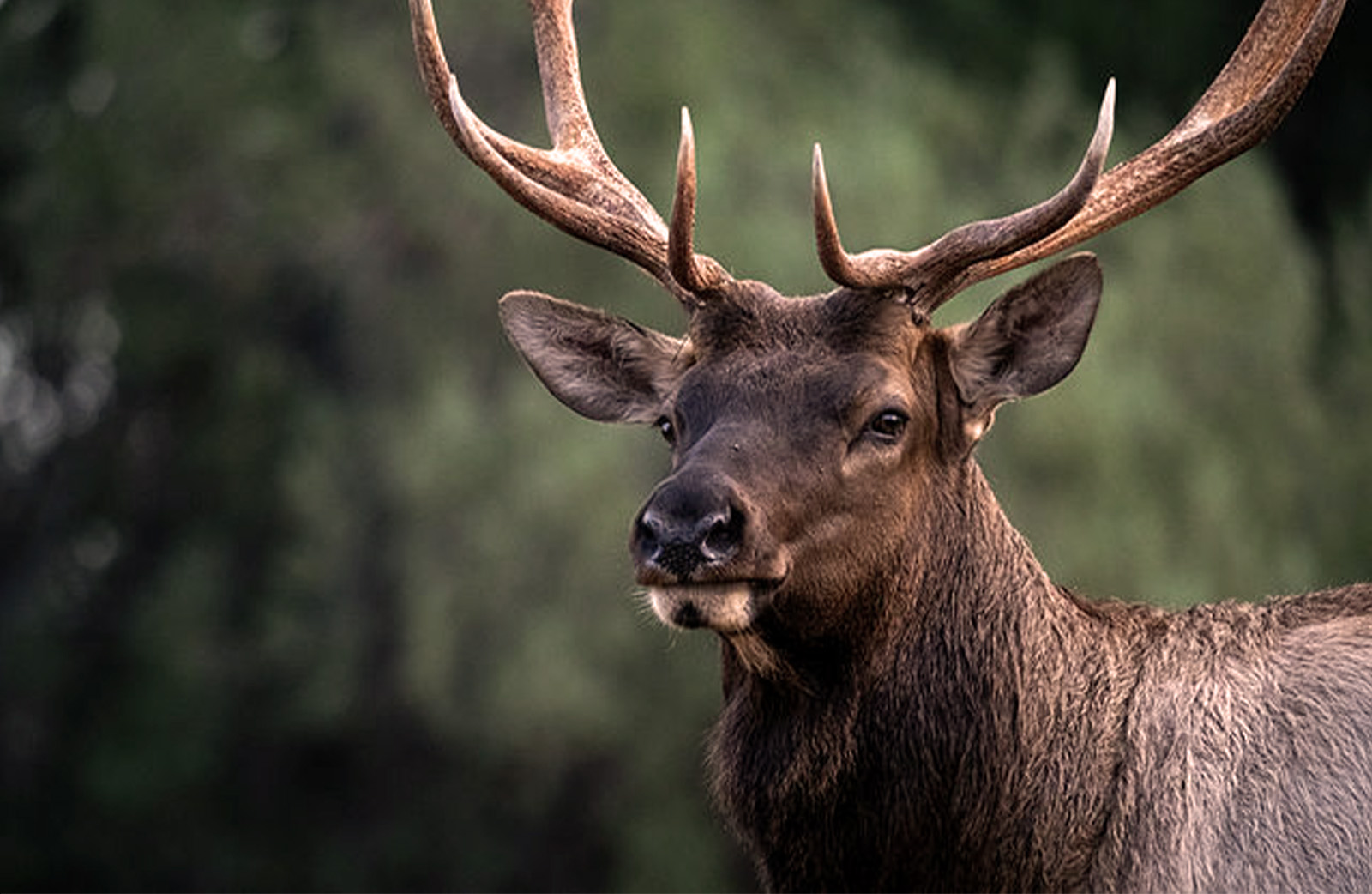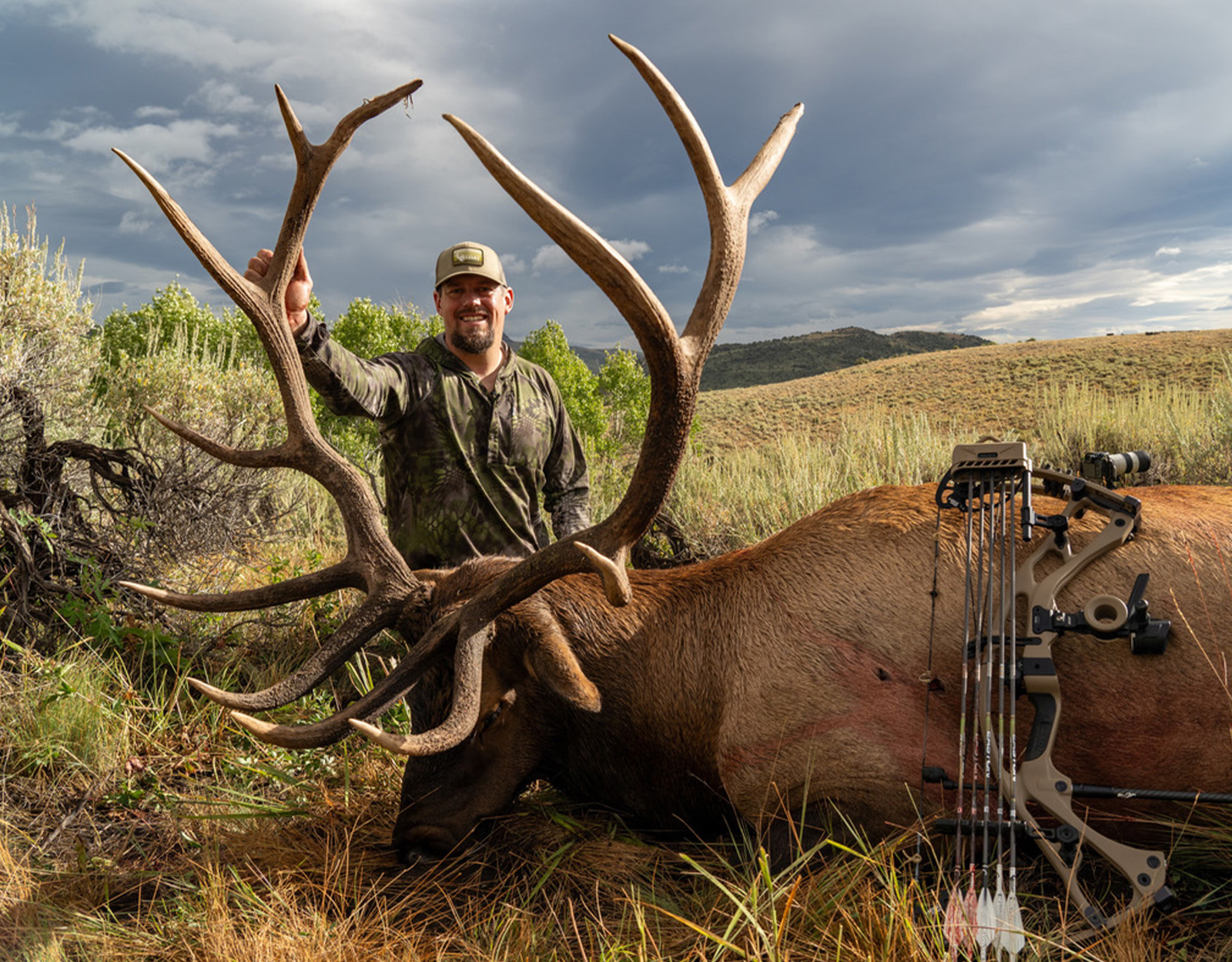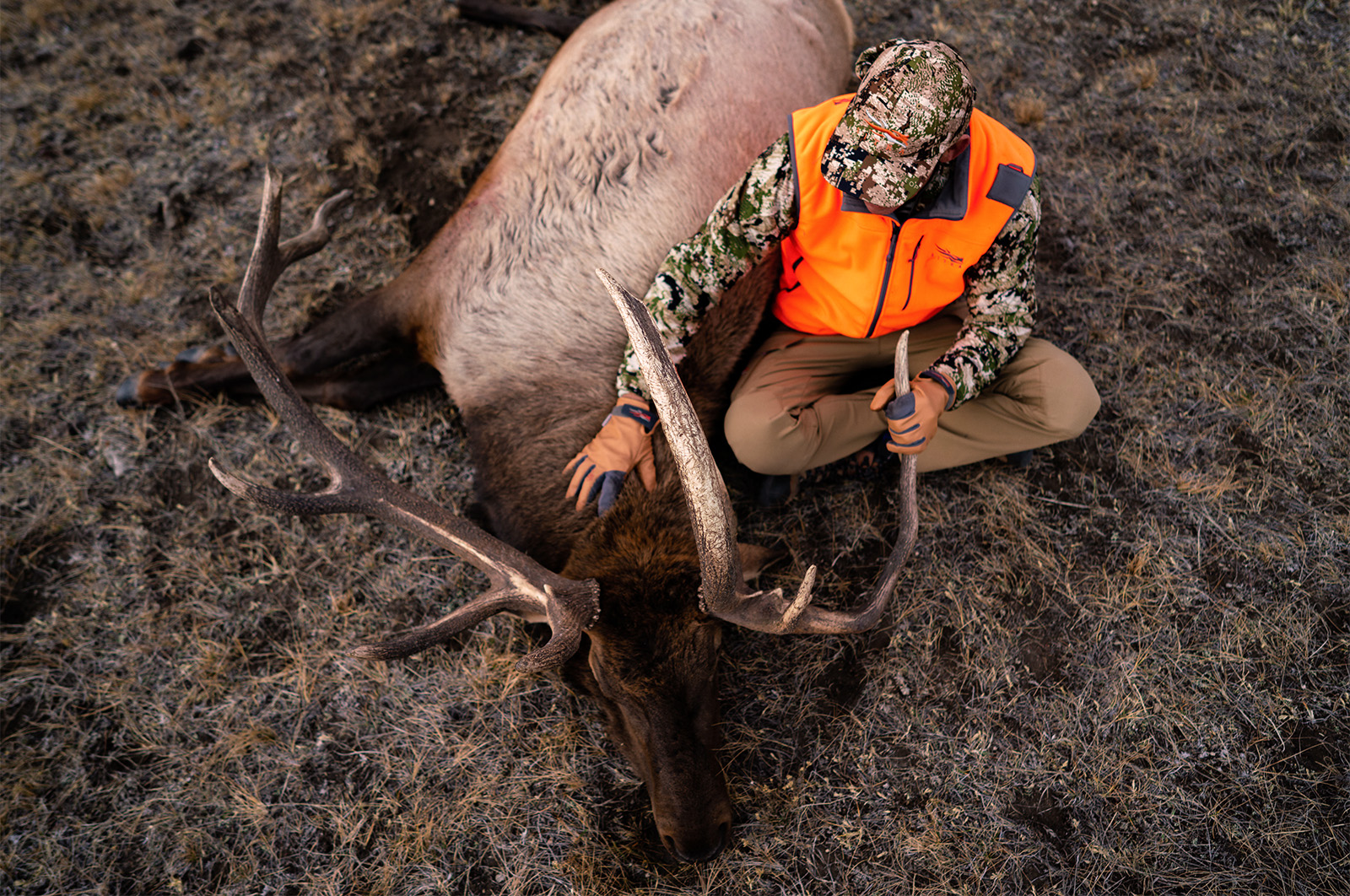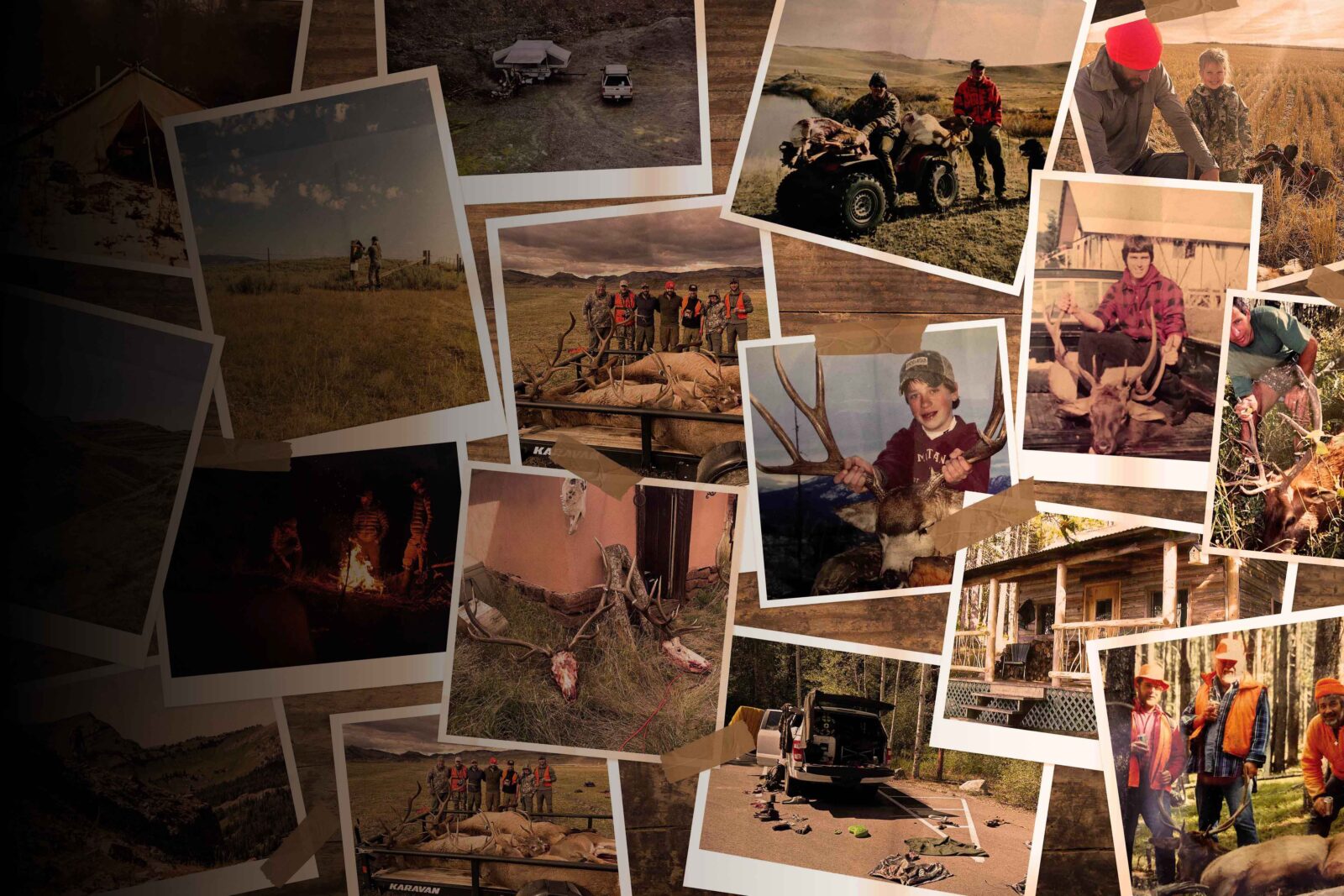From Robert Hanneman on the Huntin’ Fool team: Growing up in Northwestern Nevada, I never had the chance to go on an elk hunt in my home state due to the difficulty of drawing a tag. It was partly my desire to hunt elk that led me to move to Montana after high school. The first year that I had an elk tag in my pocket was 2000, and the learning curve on elk hunting was a lot more difficult than I expected. It was not until 2002 that I arrowed my first Montana bull. It was only a 4-point, but it is still one of my most cherished trophies.
I started applying for out-of-state tags and building points when I was in high school. I drew my first non-resident elk tag in 2003 for Idaho unit 29. I spent most of the summer scouting and was lucky enough to kill a heavy, old 6-point on opening day. On that day, I set a goal to try to kill a mature bull on public land in each of the western states. I have now taken bulls on public land in Arizona, Colorado, Idaho, Montana, New Mexico, Nevada, Oregon, and Wyoming.
TL;DR: Elk hunting opportunities across the West vary from tough-to-draw trophy hunts to easy-access over-the-counter (OTC) tags. States like Arizona, Nevada, Utah, and New Mexico are must-apply destinations for hunters chasing Boone & Crockett–class bulls, though odds are slim and landowner tags are expensive. Utah, Colorado (OTC archery is residents only), Idaho (OTC is residents only), Montana (OTC is residents only), Arizona (select areas via nonpermit tags), Oregon (select units), and Wyoming (OTC is residents only) offer more accessible hunts through OTC tags or general licenses, giving hunters consistent chances to get in the field.
Roosevelt elk can be hunted in Alaska, California, Oregon, and Washington, while California is the only state with Tule elk. By combining limited-entry applications with OTC hunts, hunters can chase elk almost every year while building preference points for trophy opportunities.
Every year, you can find my family and me in the woods chasing elk with a rifle, muzzleloader, and archery equipment. I have had the most success and killed my biggest bulls during archery hunts. There is something about screaming bulls that makes me love September. I always apply throughout the West for elk tags that fit my schedule, and then I fill in my season with over-the-counter elk hunts. I am lucky enough to usually draw a good elk tag every other year or so. With not being able to count on limited-entry tags, most of my elk hunts are with over-the-counter tags.
For this article, I will break down what I feel are the top states to apply for limited-entry Rocky Mountain elk tags where hunters are looking for trophy bulls, the best states for a hunter who is looking to hunt easy-to-obtain or over-the-counter Rocky Mountain elk tags. I will also touch on Roosevelt and Tule elk opportunities. Additionally, I have included the Boone and Crockett statistics for bulls harvested in each state.

Must-Apply-For, Limited-Entry Tag States for Rocky Mountain Elk
Arizona
Arizona is the first state that most people think of for giant bulls. They have a point system where 20% of the tags are given to the applicants with the most points, and the other 80% goes into a random draw. This gives hunters who are just starting out a chance to draw a great tag. You can expect low odds on the early rifle, early muzzleloader, and better archery tags. If you are willing to hunt the best units on the late rifle or late archery hunts, you can expect to draw tags more regularly.
Arizona also has a lot of good units that are easier to draw and still provide hunters with good opportunities at 320″+ bulls. Arizona has tons of public land, which makes for a fun hunt. Arizona has put 341 bulls into the Boone and Crockett record book. The top Boone and Crockett bulls from Arizona scored 442 5/8″ typical and 450 6/8″ non-typical.
Nevada
Nevada has a small elk population, but due to conservative management, they produce a lot of 350”+ bulls every year. At this time, nearly every unit in the state has the potential to produce a 350” bull. The toughest part of elk hunting in Nevada is drawing the tag. Nevada has a point system where they square your points. If you draw a bull tag in Nevada, you have to wait seven years to apply again.
Nevada offers landowner tags that are unit-wide. Due to the small elk population, there are not a lot of landowner tags available, and they are expensive. You can expect to pay between $12,000 and $25,000+ for a Nevada landowner tag. Nevada has put 144 bulls into the Boone and Crockett record book. The top Boone and Crockett bulls from Nevada scored 425 3/8″ typical and 434 6/8″ non-typical.
New Mexico
New Mexico doesn’t produce as many top-end bulls as Arizona, but in a wet year, a handful of giants are taken. When I think of elk hunting in New Mexico, I think about the Gila National Forest on the west side of the state. This area has a strong elk population and a lot of public land. New Mexico sets aside 10% of the tags for non-residents who apply with an outfitter and 6% of the tags for non-residents who apply on their own. There is no point system in place, so every year, you should apply for a hunt that would fit your schedule.
Another way to get a tag is to buy a landowner tag. New Mexico sells private land only tags and unit-wide tags. You can find landowner tags from $5,000 to $20,000+ for the best units. New Mexico has put 132 bulls into the Boone and Crockett record book. The top Boone and Crockett bulls from New Mexico scored 402 2/8″ typical and 434 3/8″ non-typical.
Utah
Like Nevada and Arizona, Utah produces giant bulls. The frustrating part is drawing a tag. Utah has a point system in place where half of the tags are issued to whoever has the most points, and then the other half goes into a random draw with all of the other unsuccessful applicants. There is a small chance of drawing a tag, but with the size of the bulls, we all keep applying.
Utah offers archery, rifle, and muzzleloader hunts during the rut, which makes for an exciting hunt. They also offer a second October rifle hunt, a third November rifle hunt, and a late November archery hunt. Some big bulls get tipped over on their winter range every year. Utah has landowner tags and conservation tags available. These tags are expensive and usually sell for $12,000 to $25,000+. Utah has put 261 bulls into the Boone and Crockett record book. The top Boone and Crockett bulls from Utah scored 422 5/8″ typical and 478 5/8″ non-typical.

Easy-To-Obtain or Over-the-Counter States for Rocky Mountain Elk
Colorado
Colorado has more elk than any other state, but unfortunately, they decided to reintroduce wolves. With a healthy population of 280,000 elk comes a lot of opportunity with over-the-counter tags. No matter what you are looking for, Colorado most likely has it. There are over-the-counter tags for archery (note: Colorado eliminated non-resident OTC archery elk tags in 2025), second rifle, and third rifle. With so many different over-the-counter elk hunting opportunities in Colorado, I suggest you check out pages 64-72 of our July 2023 magazine. There is a great breakdown of the better over-the-counter tags available. Colorado has put 160 bulls into the Boone and Crockett record book. The top Boone and Crockett bulls from Colorado scored 442 3/8″ typical and 463 4/8″ non-typical.
Idaho
Idaho has over-the-counter elk areas for resident rifle and archery tags. For 2026 onward, non-residents must apply for elk tags via a December draw process. You can expect crowding during the third week of September as most archery hunters are trying to catch the peak of the rut. Idaho has a number of over-the-counter backcountry units where the rifle season opens in September, giving rifle hunters a chance to chase bugling bulls. Idaho has put 106 bulls into the Boone and Crockett record book. The top Boone and Crockett bulls from Idaho scored 412 5/8″ typical and 433 1/8″ non-typical.
Montana
Montana is not really an over-the-counter state as it issues all the bull tags in the draw, but with a little planning, you can typically hunt Montana every other year. Also, there are a number of people who return their tags each year. Montana will then reissue those tags to hunters who put their names on the alternate list. Once you get your tag, most of the west side of the state is open to general hunting. Montana gives you six weeks to chase elk with a bow, five weeks with a rifle, and a nine-day muzzleloader hunt in December, so you can be chasing bulls September through December. Every year, there are a couple of great bulls taken in Montana on general tags. I always recommend hunters look towards Region 3 as it has the highest elk populations and the most public land. Montana has put 288 bulls into the Boone and Crockett record book. The top Boone and Crockett bulls from Montana scored 430″ typical and 431 7/8″ non-typical.
Oregon
Oregon went to a draw for most of its elk tags on the eastern side of the state. Most are very easy to draw and typically take just a couple of points. If you are looking for an archery over-the-counter Rocky Mountain elk tag, then you need to focus on the Lookout unit, which has a good population with decent access to the public. The Southeast Desert units also hold a smaller elk population and can be hunted on the OTC tag. Your archery elk tag is also good for Western Oregon if you decide to chase Roosevelt elk. Oregon has put 36 Rocky Mountain elk into the Boone and Crockett record book. The top Boone and Crockett bulls from Oregon scored 418″ typical and 427 1/8″ non-typical.
Utah
Utah has over-the-counter elk tags. They divide general season elk opportunities into two categories – spike only and any bull hunts. Almost all of Utah’s limited-entry bull elk units have a spike-only hunt on them. These limited-entry units have the best and highest populations of elk within them and give hunters the best potential for success. Hunting pressure is high on most of these units, and spike elk can be difficult to find once the shooting starts, but these are the best over-the-counter opportunities for hunters to fill their freezers. For the most part, any bull units have either a large amount of private land or are being managed for lower elk populations. Those units that largely consist of public land get hunted hard, and mature bulls are very difficult to find.
Wyoming
Like Montana, Wyoming does not have over-the-counter bull tags. If you want to hunt bulls, you need to apply in the draw. As of 2023, Wyoming split the general elk tag into three different regions. With that change and the increase in the special elk tag cost, I feel Wyoming should be on your list of opportunity elk states. Hunters should draw a general elk tag every two to five years, depending on the region they apply for. The Western region is the better general tag, but the Southern region will also produce some quality elk hunting. The Eastern region has a lot of private land and lower elk populations. Wyoming has put 206 bulls into the Boone and Crockett record book. The top Boone and Crockett bulls from Wyoming scored 441 6/8″ typical and 439 5/8″ non-typical.

Roosevelt Elk Opportunities
Alaska
Roosevelt elk are found in Southeast Alaska and on the Afognak and Raspberry islands near Kodiak. The tags are issued through the draw and have low draw odds. If you are lucky enough to draw, you will have an adventure between the weather and bears. Due to the remote nature of the islands, you can expect to pay plenty of transportation fees just getting there. Alaska has put 5 bulls into the Boone and Crockett record book, with the largest scoring 291 5/8″.
California
California issues Roosevelt elk tags in the draw, but the odds are horrible, and most years, a non-resident tag is never issued. They have landowner tags, which is a great way to chase Roosevelt elk if you are looking for a guided hunt. Most landowner tag guided hunt packages start at $20,000 and go up from there. California has put 169 bulls into the Boone and Crockett record book, with the largest scoring 401 3/8″.
Oregon
Oregon Roosevelt elk are found west of Interstate 5, according to Boone and Crockett. There is one draw archery unit and a handful of draw rifle units for Roosevelt elk. The rest of the state is over-the-counter for Roosevelts. If you want to chase Roosevelts in the thick country of Western Oregon, your best bet is during the archery season as bulls are bugling. If you are a rifle hunter, it is going to be tough on public land. Glassing clear-cuts and burns is your best bet of filling your tag. Oregon has put 233 Roosevelt elk into the Boone and Crockett record book, with the largest scoring 404 6/8″.
Washington
Washington is much like Oregon, as the Roosevelt elk are found west of Interstate 5, according to Boone and Crockett. Roosevelt elk are located on the coast, and the same tactics used in Oregon apply here. Washington offers over-the-counter rifle and archery elk tags. Washington has put 106 Roosevelt elk into the Boone and Crockett record book, with the largest scoring 380 6/8″.
Tule Elk Opportunities
California
Tule elk are only found in California. They prefer the grasslands and marshlands of the central valley to the grassy hills on the coast. They are the smallest of the three subspecies of elk. Mature bulls weigh on average 500 pounds, with a few pushing 600+ pounds. These bulls rut in August, which is earlier than the Rocky Mountain and Roosevelt elk. As a non-resident, your odds of drawing the one elk tag in California are way less than 1%. Most hunters who want a Tule elk buy a landowner tag. A landowner elk tag and an outfitted hunt will run anywhere from $20,000 to $40,000 for a mature bull. Some hunters will book a Tule cow elk hunt, as it still counts for your North America 29. For a Tule cow elk hunt, you can expect $5,000 to $7,500. California has put 133 Tule elk into the Boone and Crockett record book, with the largest scoring 379″.
The West has tons of opportunities to hunt elk. You should be hunting elk every year, as there is always an easy way to get a tag. If you are looking to go on a good guided elk hunt, give Huntin’ Fool Adventures a call as these guys work directly with some of the best outfitters in the business. If you have any questions about elk hunting, strategy, or developing an application plan, give us a call at the Huntin’ Fool office.


Your Complete System for Securing Tags
Whether you’re chasing a once-in-a-lifetime hunt or just looking to fill the freezer, your season starts with onX Hunt’s application tools—all included with an Elite Membership:
- Hunt Research Tools: Draw odds, tag trends, and harvest stats for 11 western states (Washington is not yet available) to help you decide where to apply.
- Huntin’ Fool: In-depth insights to navigate state-specific systems and build better strategies.
- HuntReminder: Text and email alerts so you never miss a deadline.
One membership, every tool you need to make 2026 the year.

FAQs
Limited-entry tags are controlled through state draws and can offer access to trophy-quality elk. Odds may be low, but these hunts are managed for larger bulls and less pressure.
Arizona, Nevada, Utah, and New Mexico consistently produce record-book bulls but are difficult to draw. Landowner and conservation tags are alternatives, though they can cost $12,000–$25,000+.
Utah, Colorado (archery is residents only), Idaho (residents only), Montana (residents only), Wyoming (residents only), Arizona (select areas via nonpermit tags), and Oregon (select units) provide OTC opportunities.